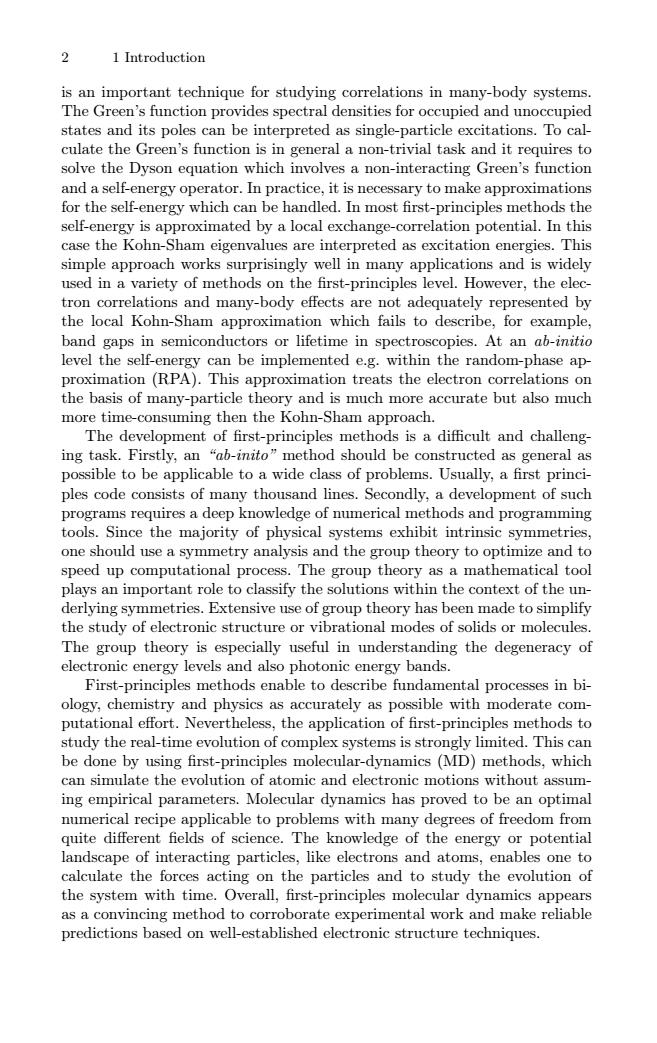正在加载图片...

2 1 Introduction is an important technique for studying correlations in many-body systems. The Green's function provides spectral densities for occupied and unoccupied states and its poles can be interpreted as single-particle excitations.To cal- culate the Green's function is in general a non-trivial task and it requires to solve the Dyson equation which involves a non-interacting Green's function and a self-energy operator.In practice,it is necessary to make approximations for the self-energy which can be handled.In most first-principles methods the self-energy is approximated by a local exchange-correlation potential.In this case the Kohn-Sham eigenvalues are interpreted as excitation energies.This simple approach works surprisingly well in many applications and is widely used in a variety of methods on the first-principles level.However,the elec- tron correlations and many-body effects are not adequately represented by the local Kohn-Sham approximation which fails to describe,for example, band gaps in semiconductors or lifetime in spectroscopies.At an ab-initio level the self-energy can be implemented e.g.within the random-phase ap- proximation(RPA).This approximation treats the electron correlations on the basis of many-particle theory and is much more accurate but also much more time-consuming then the Kohn-Sham approach. The development of first-principles methods is a difficult and challeng- ing task.Firstly,an "ab-inito"method should be constructed as general as possible to be applicable to a wide class of problems.Usually,a first princi- ples code consists of many thousand lines.Secondly,a development of such programs requires a deep knowledge of numerical methods and programming tools.Since the majority of physical systems exhibit intrinsic symmetries, one should use a symmetry analysis and the group theory to optimize and to speed up computational process.The group theory as a mathematical tool plays an important role to classify the solutions within the context of the un- derlying symmetries.Extensive use of group theory has been made to simplify the study of electronic structure or vibrational modes of solids or molecules. The group theory is especially useful in understanding the degeneracy of electronic energy levels and also photonic energy bands. First-principles methods enable to describe fundamental processes in bi- ology,chemistry and physics as accurately as possible with moderate com- putational effort.Nevertheless,the application of first-principles methods to study the real-time evolution of complex systems is strongly limited.This can be done by using first-principles molecular-dynamics (MD)methods,which can simulate the evolution of atomic and electronic motions without assum- ing empirical parameters.Molecular dynamics has proved to be an optimal numerical recipe applicable to problems with many degrees of freedom from quite different fields of science.The knowledge of the energy or potential landscape of interacting particles,like electrons and atoms,enables one to calculate the forces acting on the particles and to study the evolution of the system with time.Overall,first-principles molecular dynamics appears as a convincing method to corroborate experimental work and make reliable predictions based on well-established electronic structure techniques.2 1 Introduction is an important technique for studying correlations in many-body systems. The Green’s function provides spectral densities for occupied and unoccupied states and its poles can be interpreted as single-particle excitations. To calculate the Green’s function is in general a non-trivial task and it requires to solve the Dyson equation which involves a non-interacting Green’s function and a self-energy operator. In practice, it is necessary to make approximations for the self-energy which can be handled. In most first-principles methods the self-energy is approximated by a local exchange-correlation potential. In this case the Kohn-Sham eigenvalues are interpreted as excitation energies. This simple approach works surprisingly well in many applications and is widely used in a variety of methods on the first-principles level. However, the electron correlations and many-body effects are not adequately represented by the local Kohn-Sham approximation which fails to describe, for example, band gaps in semiconductors or lifetime in spectroscopies. At an ab-initio level the self-energy can be implemented e.g. within the random-phase approximation (RPA). This approximation treats the electron correlations on the basis of many-particle theory and is much more accurate but also much more time-consuming then the Kohn-Sham approach. The development of first-principles methods is a difficult and challenging task. Firstly, an “ab-inito” method should be constructed as general as possible to be applicable to a wide class of problems. Usually, a first principles code consists of many thousand lines. Secondly, a development of such programs requires a deep knowledge of numerical methods and programming tools. Since the majority of physical systems exhibit intrinsic symmetries, one should use a symmetry analysis and the group theory to optimize and to speed up computational process. The group theory as a mathematical tool plays an important role to classify the solutions within the context of the underlying symmetries. Extensive use of group theory has been made to simplify the study of electronic structure or vibrational modes of solids or molecules. The group theory is especially useful in understanding the degeneracy of electronic energy levels and also photonic energy bands. First-principles methods enable to describe fundamental processes in biology, chemistry and physics as accurately as possible with moderate computational effort. Nevertheless, the application of first-principles methods to study the real-time evolution of complex systems is strongly limited. This can be done by using first-principles molecular-dynamics (MD) methods, which can simulate the evolution of atomic and electronic motions without assuming empirical parameters. Molecular dynamics has proved to be an optimal numerical recipe applicable to problems with many degrees of freedom from quite different fields of science. The knowledge of the energy or potential landscape of interacting particles, like electrons and atoms, enables one to calculate the forces acting on the particles and to study the evolution of the system with time. Overall, first-principles molecular dynamics appears as a convincing method to corroborate experimental work and make reliable predictions based on well-established electronic structure techniques